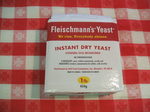
All About Yeast Fellow Whole Grain Bread Makers:
I wanted to share some information I learned about yeast. I hope you find it informative and will help you when baking bread. I have had a few folks ask why their bread does not raise as much as mind did in class. My first thought is how old is your yeast? When that is not the issue the type of yeast may be a problem.
If active dry yeast is what you have try adding a bit more to the recipe. Another tip that may help is adding vitamin C as a yeast booster. The vitamin C will make the yeast work harder and longer. It will also act as a preservative to prevent mold and bacterial growth on your bread. I have used vitamin C pills crushed or Fruit Fresh used in canning. You will need about 1/8 teaspoon per loaf of bread so not that much.
I do sell 1 lb. instant yeast, for $6.00 will last you years if kept frozen.I hope this information will help make your baking experiences rise to new heights.
Tamara Carl
I wanted to share some information I learned about yeast. I hope you find it informative and will help you when baking bread. I have had a few folks ask why their bread does not raise as much as mind did in class. My first thought is how old is your yeast? When that is not the issue the type of yeast may be a problem.
- Cake yeast which really is not available to most of us is live yeast which needs to be dissolved before using.
- Active dry yeast which is the traditional yeast you buy in the small envelopes or the 4 oz jars. How this is made is each granular has a coating of dead dried yeast and an inner core of live dried yeast. Active dry yeast must always be hydrated in liquid to activate the yeast. The liquid will wash away the dead yeast exposing the dried live yeast inside each granular. Ounce for ounce this form of yeast has less active yeast, which in turn means less raising power when it comes to bread.
- Instant yeast is made different, the dried yeast is coated with citric acid (vitamin C). Citric acid is a yeast booster, and will help give the yeast a better environment to live and grow. This yeast is more concentrated than the Active yeast since it does not have the dead dried yeast as a coating. Instant yeast may also be added directly to the flour no need to bloom in the liquid.
- Rapid Rise yeast has several yeast enhancers added to it. This yeast is made for bread machines and sometimes is marketed as bread machine yeast. You do not have to bloom this type of yeast before adding to the flour. The main draw back to this yeast is timing if you let it rise to long there is no going back. Since it’s made to work quickly the flavor of the bread will not be as good as a longer raise.
If active dry yeast is what you have try adding a bit more to the recipe. Another tip that may help is adding vitamin C as a yeast booster. The vitamin C will make the yeast work harder and longer. It will also act as a preservative to prevent mold and bacterial growth on your bread. I have used vitamin C pills crushed or Fruit Fresh used in canning. You will need about 1/8 teaspoon per loaf of bread so not that much.
I do sell 1 lb. instant yeast, for $6.00 will last you years if kept frozen.I hope this information will help make your baking experiences rise to new heights.
Tamara Carl
 RSS Feed
RSS Feed
